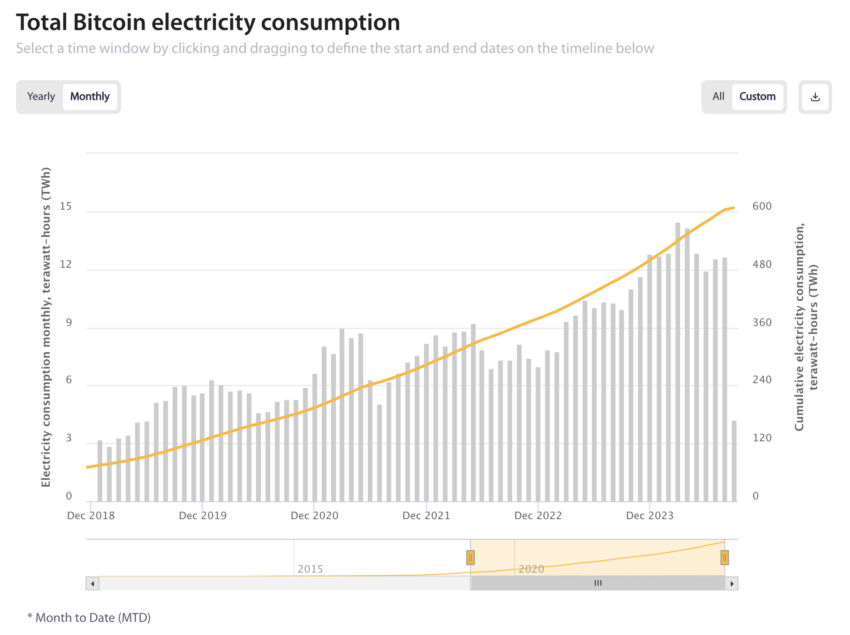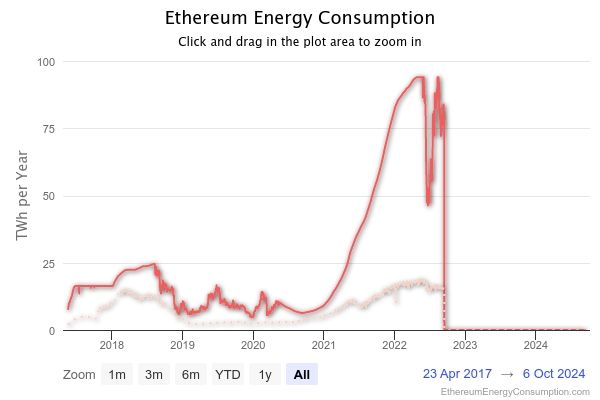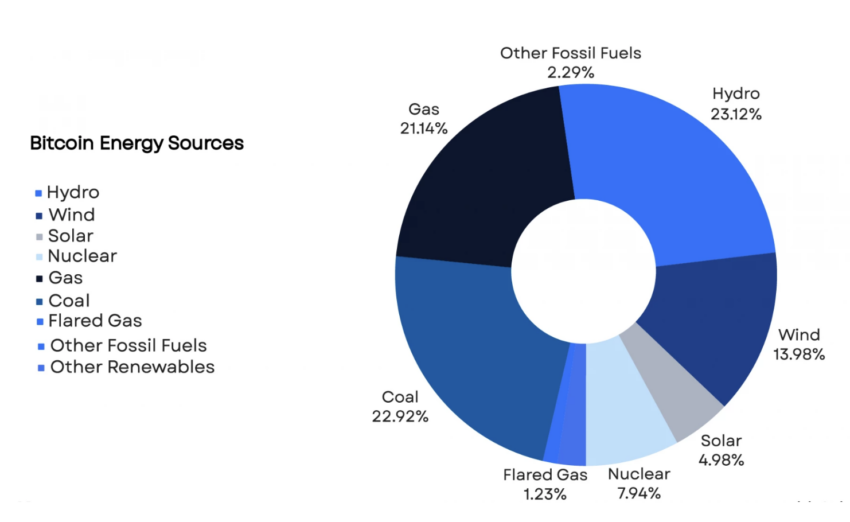The debate over cryptocurrencies’ environmental impact has intensified as governments, corporations, and investors focus on Environmental, Social, and Governance (ESG) concerns. Bitcoin, the world’s most prominent cryptocurrency, is leading the criticism, known for its energy-intensive Proof-of-Work (PoW) consensus mechanism.
While innovations are emerging across the crypto industry to address environmental concerns, Bitcoin’s contribution to global carbon emissions remains a major point of contention.
Bitcoin’s Environmental Problem
Bitcoin’s PoW mechanism relies on miners solving complex cryptographic problems, consuming vast amounts of computational power and energy.
According to estimates from the University of Cambridge, Bitcoin’s annual energy consumption rivals that of entire nations such as Argentina or Norway. Moreover, Bitcoin’s environmental footprint is exacerbated in regions where mining operations are powered by non-renewable energy sources.
“Bitcoin mining may be responsible for 65.4 megatonnes of CO2 (MtCO2) per year, which is comparable to country-level emissions in Greece (56.6 MtCO2 in 2019) and represents 0.19% of global emissions,” a report titled Revisiting Bitcoin’s Carbon Footprint read.

Critics argue that this consumption is disproportionate and unsustainable, especially in light of global climate commitments. While alternative cryptocurrencies are exploring eco-friendly mechanisms, Bitcoin’s slow adaptation to such technologies has raised concerns.
“Everybody recognizes Bitcoin is environmentally unhealthy, but any big changes to Bitcoin protocol have been very unsuccessful because you need to get all the miners to agree on that,” Hanna Halaburda, Associate Professor of Information at NYU Stern School of Business, said.
If environmental sustainability becomes a core expectation of investors and regulators, Bitcoin may soon face increasing pressure to upgrade.
A Green Shift in Crypto
In contrast to Bitcoin, other blockchain platforms have already taken steps to reduce their environmental impact. Ethereum, for instance, made headlines in 2022 with its shift from PoW to Proof-of-Stake (PoS), cutting its energy consumption by over 99%. PoS replaces energy-hungry mining with validators who lock up tokens as collateral to secure the network.
This transformation set a precedent for the industry, showing that eco-friendly upgrades are possible even in established networks.
Read more: Proof of Work and Proof of Stake Explained

Other platforms like Hedera, Cardano, and Tezos also boast PoS mechanisms and are increasingly focusing on sustainability. Hedera’s involvement in carbon offsetting projects and its collaboration with the Global Blockchain Business Council (GBBC) to promote environmental standards are further steps toward reducing blockchain’s ecological footprint.
In an exclusive interview with BeInCrypto, Wes Geisenberger, Vice President of Sustainability and ESG at HBAR, noted the importance of the GBBC InterWork Alliance’s Carbon Emission Token (CET) Task Force. This task force, developed to address carbon accounting at a technical level, is helping companies navigate these regulations.
“The CET is a positive contribution, very much driven by the changes coming from governments and corporates looking for solutions to credibly address their environmental impact,” Geisenberger said.
This kind of technical development highlights the growing intersection of blockchain and environmental governance. The crypto industry is increasingly collaborating with government bodies and international organizations to find solutions that meet regulatory expectations while leveraging blockchain’s potential to innovate.
Investors are Paying Attention
Investor sentiment is increasingly aligned with global ESG priorities. Climate-conscious investors are urging industries, including crypto, to take accountability for their environmental impact. In response, some blockchain ecosystems are leading climate-focused efforts, both through technological innovation and by funding sustainable projects.
According to Geisenberger, the HBAR Foundation’s Sustainable Impact Fund is one of the first grant-based funds aimed at promoting blockchain’s role in sustainability. This fund supports initiatives like the Hedera Guardian, a public ledger platform designed to improve transparency in carbon credit markets.
By enabling institutions and startups to track and verify their carbon-offsetting efforts, Hedera has shown how blockchains can facilitate responsible environmental practices.
“The Hedera Guardian has already onboarded 500 million metric tonnes of carbon credits. We see these tools helping answer challenges to enable outcomes to measure our planet’s externalities and give agency to folks participating in environmental and biodiversity projects to better trace flows of funds back to the community,” Geisenberger explained.
Despite these positive developments in the broader blockchain ecosystem, Bitcoin’s reliance on PoW remains unchanged. Bitcoin advocates argue that its decentralized nature and security features are unparalleled and that any shift in its consensus mechanism could jeopardize its integrity. They point to Bitcoin miners’ adoption of renewable energy as a possible solution to its environmental challenges.
Some mining operations are indeed migrating to regions with abundant hydroelectric, wind, and solar power. However, these efforts are still piecemeal and lack industry-wide coordination.
“A lot of Bitcoin mining companies have set up their contracts with renewable energy companies. The argument is that having these mining facilities as clients means that when there’s an oversupply of energy, it may actually make it more profitable for the renewable energy plants,” Halaburda added.
Read more: 5 Best Platforms To Buy Bitcoin Mining Stocks After 2024 Halving

The question, then, is whether Bitcoin will be able to evolve in an increasingly ESG-driven world. The industry’s focus on renewable energy and carbon offsetting projects offers some hope, but it may not be enough if regulatory frameworks impose stricter environmental requirements.
Challenges in Standardizing ESG Metrics
While some crypto platforms have made strides toward sustainability, the challenge of standardizing ESG metrics across the industry persists. Blockchain technology’s decentralized and often opaque nature complicates the task of measuring environmental impact consistently and comparably.
Efforts like the CET protocol are helping to fill this gap, but broader industry-wide adoption is necessary for meaningful change. Without standardization, it remains difficult to gauge which platforms are truly sustainable and which are relying on surface-level commitments.
There is also the challenge of balancing the interests of investors, users, and environmental advocates, each of whom has different expectations regarding the future of blockchain technology.
As regulations tighten and the global push for sustainability accelerates, Bitcoin’s environmental footprint will likely become harder to ignore. The crypto industry has demonstrated that it can innovate and adapt, but Bitcoin, as the original and most influential cryptocurrency, faces an uphill battle. It may ultimately require either an upgrade in its consensus mechanism or a significant investment in renewable energy solutions.
 beincrypto.com
beincrypto.com
